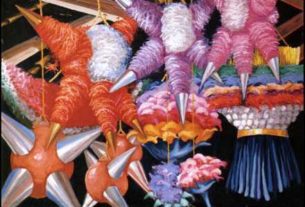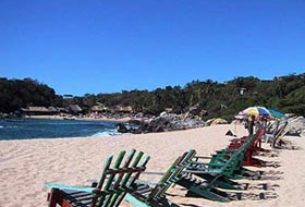Mexican Kitchen
One of the regions of Mexico most indelibly fixed in my mind is the Yucatan, probably because the sights, sounds, flavors and aromas are so sensual that they create truly visceral memories. When my husband and I reminisce about our journeys throughout Mexico, especially the long road trips taken in our trusty old Ford pickup, talk inevitably turns to the Yucatan and our favorite ruins (his – Chichen Itza, mine – Uxmal) and foods (his – cochinita pibil, mine – relleno negro.)
Of all the places we visited, the city of Merida was undoubtedly the most fascinating in terms of the cuisine and its many unique elements. Its restaurants and markets opened up a world of bright, citrusy flavors and exotic spice blends quite unlike anything found in other parts of the country.
In order to learn more about what makes the Yucatecan culinary landscape so different, Mexconnect interviewed Chef David Sterling of Merida’s Los Dos cooking school. Chef Sterling was raised on Southwestern cooking, trained in classic French techniques, and now focuses on Mexican cuisine. After 25 years in New York City, Chef Sterling moved to Merida in 2003 to open Los Dos. His extensive research into the local culinary traditions, plus a dedication to the integrity of the regional techniques and ingredients, makes him an ideal source of insight and information.
M.C. How does the Yucatan’s cuisine differ from other Mexican cuisines?
D.S. I always describe Yucatecan cuisine as a Maya platform with European influences on top. The Maya foundation is profound and ancient: fritters of corn, beans and squash; sauces made of pumpkin seeds and local herbs. We also had a direct Caribbean influence from the Arawak speaking peoples of the islands. Barbeque – the most famous example – and many other influences came directly from them to Yucatan, and then beyond. And there are European foods right on top: longaniza sausage from Portugal, the red ball cheeses from Holland, kibis from Lebanon, alcaparrado (capers, raisins and olives) from the Moorish influence of Andalusia, and all the influences from the European colonies in the Caribbean (plantains, rum, cane sugar.) While European influences mix to some degree with indigenous foods in Mexico, I do not believe that the mixture is nearly as profound as the fusion that happens in Yucatan.
M.C. Why would travelers choose the Yucatan as a cooking destination?
D.S. All of Mexico is wonderful for its food, but Yucatan is interesting because of the European and Caribbean influences that mixed with the Maya traditional forms. I also think that the ingredients in Yucatan are so interesting: the tropical fruits; the habanero, one of the world’s hottest chiles; achiote, indigenous to the Amazon basin but used primarily in “Mayaland;” chaya, one of the world’s healthiest vegetables; our pib, or pit, cooking; and the unique tamales not found anywhere else in Mexico.
M.C. What distinctly Yucatecan cooking techniques do students learn at Los Dos? Do you do any cooking in a pib?
D.S. Students of Los Dos learn several distinctly Yucatecan culinary techniques. We tend to char things directly in a fire more so than cooks in other parts of Mexico. We set chiles on fire to make charred chile paste marinades. We cook in pibes, underground ovens which we occasionally visit in person. In class, we have adapted a stovetop smoking method that people can do at home. We use recados – spice blend marinades, the precursors to mole. There are also several more subtle things our students learn, such as how we fry achiote seeds in lard to stain the fat bright orange, then mix it with tamales or rice, giving them a distinctive yellow color. Students also learn, among other techniques, a straining method that achieves the creamy perfection required for a dish like frijol colado, a bean tamal, and how to wrap food in banana leaves before cooking.
M.C. What are the characteristic ingredients unique to the Yucatan?
D.S. Our recados are totally native to Yucatan. We have about thirteen different varieties, differing in color and flavor according to the principal ingredient used. Achiote (red) is our most popular one and chilmole, made with black, charred chiles, is probably the second most popular. We also have a brown/green one made with Mexican oregano and peppercorns, and a bright green one made from fresh pumpkin seeds. Other unique ingredients include naranja agria (sour orange), habaneros, chaya, and two local bean varieties called ibes and espelones, which figure prominently in the regional cuisine. Then there are the many tropical fruits, including nance, mamey and marañon, from which the cashew nut grows. Cacao, first cultivated on a large sale by the Maya, is still sold in grain form in the Merida market.
M.C. What level of cooking do students need before taking classes?
D.S. Our students are mostly amateur home cooks, or just food lovers. They need no special skills. More than anything, they are interested in culture, more specifically the culture of this most unique region of the world.
If you are interested in taking classes in this warm, friendly and intriguing part of Mexico, contact Chef Sterling. Beyond classes, there is plenty to explore in Yucatan, including ancient Maya archaeological sites, beaches and eco-reserves. For those not able to experience the Yucatan in person, Chef Sterling has agreed to share some recipes, including one for a salad that uses the winter fruit in season right now, and a dip based on pre-Conquest Mayan ingredients.
- Jicama and Mandarin Orange Salad: Ensalada Xec
- Pumpkin Seed Salad Dressing or Dip: Salsa de Pepitas
- Cream of Cilantro Soup: Crema de Cilantro
- Caballeros Ricos: Bread Pudding Soufflé with Cinnamon Syrup and Nuts


